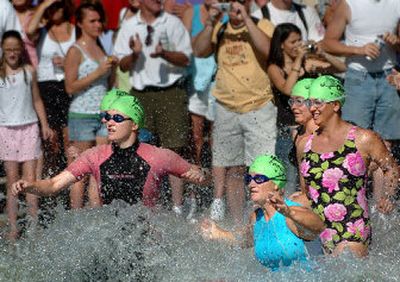Valley Girls share a peak experience

They came from Nine Mile Falls and Walla Walla; Poulsbo; Portland; Okotoks, Alberta; and Colorado Springs, Colo.
But they’re all Valley Girls.
The 500 women of the third annual Valley Girl Triathlon wound their way through Liberty Lake on Sunday – swimming a third of a mile, biking 12 miles and running three.
They are all now part of a sisterhood of sweat, wearing their race numbers in indelible ink on their left triceps and their ages in the same ink on their left calves. The youngest, 9-year-old Sarah Jydstrup, was part of a three-person team with her mother and grandmother. The youngest to do all three legs was 12-year-old Briony Denker of Spokane; the oldest, Annette Orton, 75, of Sandpoint.
They all started the race together; they all finished.
For the first women across the finish line, led by Annie Warner of Nine Mile Falls, it was about how fast they could finish a sprint-distance triathlon – the sport’s shortest.
Warner, who turned in the fastest swim time (8 minutes, 52 seconds), was the only one to break the one-hour barrier, finishing in 58:26.
For others, however, it was about finding the inner strength to do something new.
Janice Sahagian and Lisa Martin, wearing identical pink and white running gear, crossed the finish line together. After turning in their race numbers to finish the race, but before having their electronic timers removed from their ankles, they stopped in the middle of the finish chute for an embrace.
“We did it!” they cried in unison.
“We’re, well, I’m getting old,” said Sahagian, 47. “And this was just a personal fitness goal. I just wanted to see if I could do it, and it’s been great. It made me get in the pool after years and years and years.”
“And it motivated us to work out every single day,” Martin, 39, added. “This was our motivation – and we weren’t last!”
Sahagian even got her daughter, Jane Kimbrell, 27, to join in, flying up from Colorado Springs to make it a threesome.
“She asked me if I wanted to join in and I said, ‘Sure,’ ” Kimbrell said. “This was such a friendly atmosphere. The people are all so supportive and it didn’t feel as competitive as I thought it would be. It was a lot of fun.”
Marla Emde, the race director, and Robin DeRuwe, owner of Fitness Fanatics, started the women-only sprint-distance Valley Girl race as a way of attracting runners like Sahagian, Martin and Kimbrell – who had never done a triathlon but were willing to give it a try.
The race’s popularity has grown steadily. The first year 350 women took part; this year the race filled all 500 entries by March.
“We could easily have done 800 this year,” Emde said.
Putting on the event hasn’t gotten any easier, she said.
“It’s a little bit like putting on a circus,” she said. “Once you get everyone inside the tent you tend to forget just how much work went into getting that tent up and bringing in the lions and tigers.”
But the rewards, she said, make the effort worthwhile.
This year, one of those rewards was the story of the last woman to finish the swim.
Volunteers dot the course, all of them enthusiastically supportive of every entrant. During the swim leg, volunteers use kayaks to provide moral support as well as a place for out-of-breath swimmers to take a break.
“This particular woman got about a third of the way out and told one of the guys in the kayak that she couldn’t do it and she was going to turn back,” Emde said. “He wouldn’t let her quit, he stayed with her the rest of the way – not for propulsion, but he encouraged her the whole way and stayed right there with her.
“When she finally came out of the water she just broke down in tears. We all gave her a hug.”
That, Emde says, is the difference between the Valley Girl and bigger triathlons like the Ironman.
“I have clients who do the Ironman,” she said. “The Ironman is emotional, too, but not in the way this race is.”
The support along the course is palpable. Virtually every racer is given a big hand as she comes out of the water; each has her name called out as she crosses the finish line.
“Hey,” one young girl announced with pride, “my grandma is faster than your grandma.”
Some racers found encouraging banners made by family members along the course. “Go, Mama Go” was a popular sentiment. Racer No. 505, Becky Stafford from Coeur d’Alene, found hers written on the asphalt in chalk.
Most racers crossed the finish line to find children, parents, spouses, friends and fellow racers waiting with hugs.
As they finished, all the women wore looks of pride. And that, in a nutshell, is why they all were there.